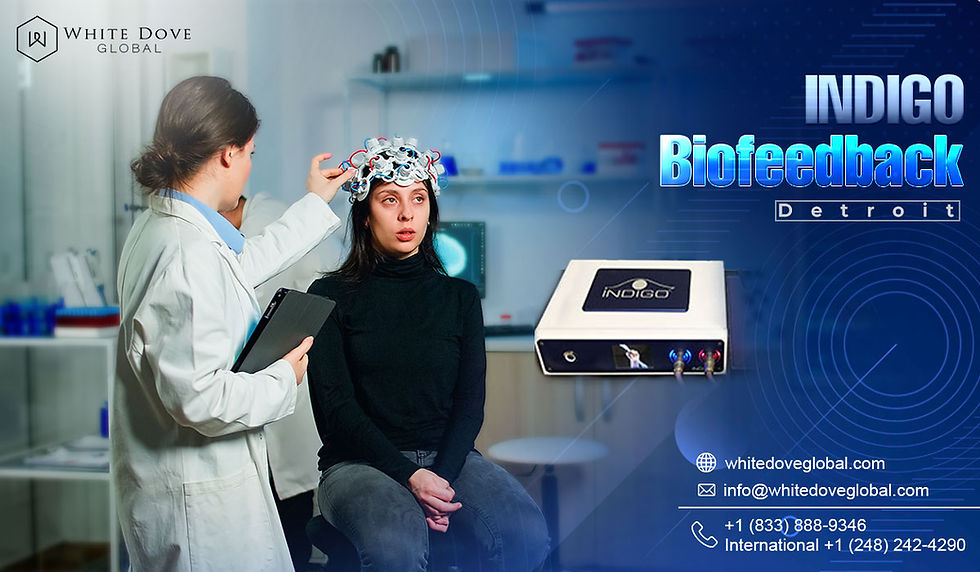Understanding Biofeedback Technology: A Revolutionary Approach To Health
- whitedoveglobal
- Dec 20, 2024
- 3 min read
Biofeedback technology is an innovative method that allows individuals to gain awareness and control over physiological functions. This technology uses instruments to measure bodily processes, providing real-time data to help users understand and improve their health. In this blog, we will delve into the various applications of biofeedback technology Detroit for health purposes, its efficacy, and how it can benefit practitioners and patients alike.

What is Biofeedback Technology?
Biofeedback technology involves using electronic monitoring devices to help individuals gain control over physiological functions that are typically involuntary. These functions include heart rate, blood pressure, muscle tension, and skin temperature. By providing real-time information, biofeedback helps users learn to recognize and alter their physiological responses.
Key Components of Biofeedback Technology
Sensors: These are attached to the body to measure physiological metrics such as heart rate variability, muscle tension, and skin conductivity.
Feedback Loop: The data is sent to a computer or a handheld device, which displays it in a way that users can understand, often through graphs or visual indicators.
Training Sessions: Users engage in sessions where they learn to modify their physiological responses through techniques such as relaxation training, visualization, or mindfulness.
5 Health Benefits of Biofeedback Technology
Biofeedback technology serves various health purposes, offering a range of benefits:
1. Stress Reduction
Biofeedback helps individuals identify stress triggers and manage their bodily responses. A study published in the Journal of Clinical Psychology revealed that participants using biofeedback techniques experienced a 50-60% reduction in perceived stress levels.
2. Pain Management
Those suffering from conditions like fibromyalgia, migraines, or back pain can use biofeedback to monitor and manage their pain. According to the American Academy of Pain Medicine, nearly 70% of individuals using biofeedback for pain management report a significant decrease in pain intensity.
3. Improved Focus and Concentration
Biofeedback can be an effective tool for children and adults diagnosed with Attention Deficit Hyperactivity Disorder (ADHD). A meta-analysis conducted by the Journal of Attention Disorders found that individuals with ADHD who utilized biofeedback technology showed an 87% improvement in focus compared to control groups.
4. Enhanced Athletic Performance
Many athletes use biofeedback for mental training, enhancing performance through better stress and anxiety management. The United States Olympic Committee has integrated biofeedback techniques into training programs for elite athletes to achieve optimal performance.
5. Rehabilitation
Biofeedback assists in the rehabilitation of muscle injuries by providing real-time data on muscle performance. Studies have demonstrated that patients engaged in biofeedback-assisted rehabilitation recover 30% faster than those who do not use the technology.
Types of Biofeedback Technology
Biofeedback technology in Detroit comes in various forms, each tailored to specific needs:
1. Electromyography (EMG) Biofeedback:
It measures muscle tension through electrical activity. The device helps in managing muscle dysfunction and tension-related pain.
2. Thermal Biofeedback:
It monitors skin temperature as a measure of relaxation and stress response. This tool is often used for headaches and stress management.
3. Neurofeedback:
It targets brainwave activity to help with mental health issues. The device is very useful in treating anxiety, depression, and ADHD.
4. Heart Rate Variability (HRV) Biofeedback:
The device examines heart rate patterns to provide insights into stress and emotional responses. It helps in improving cardiovascular health and emotional regulation.
The Future of Biofeedback Technology in Healthcare
Biofeedback technology continues to evolve, propelled by advancements in digital health solutions. The integration of mobile health apps and wearables is making biofeedback more accessible to the general public. Here is what the future holds:
Increased Accessibility: As digital health continues to grow, biofeedback devices will become more widely available, allowing users to monitor their health from home.
Data Integration: The combination of biofeedback data with smart health analytics will enable more personalized health management strategies.
Telehealth Integration: Biofeedback sessions can be conducted virtually, making it easier for practitioners to guide patients regardless of location.
Innovative Research: Ongoing studies will likely uncover new applications and effectiveness of biofeedback technology across a range of health conditions.
Conclusion
Biofeedback technology offers a variety of health benefits, from stress reduction to enhanced athletic performance. Its ability to provide real-time feedback empowers individuals to take control of their health in a proactive manner. With its diverse applications and advancements, biofeedback technology is poised to play a significant role in wellness and rehabilitation.
If you are a health practitioner and interested in incorporating biofeedback technology in West Bloomfield into your practice, you can reach out to White Dove Global Marketing Ltd. They can equip you with the latest biofeedback devices; and as a result, you support your patients effectively on their journey to better health. Explore what we have to offer and transform your healthcare practice today!



Comments